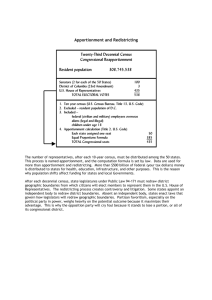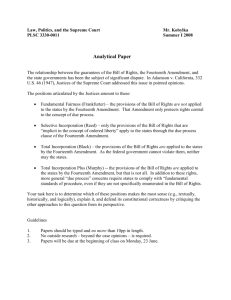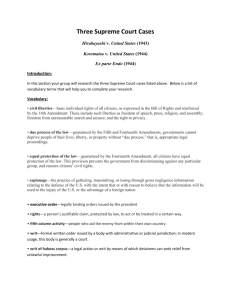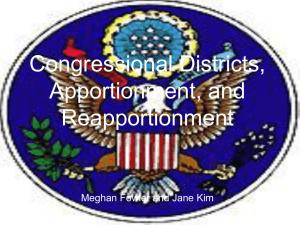Supreme Court of the United States
advertisement
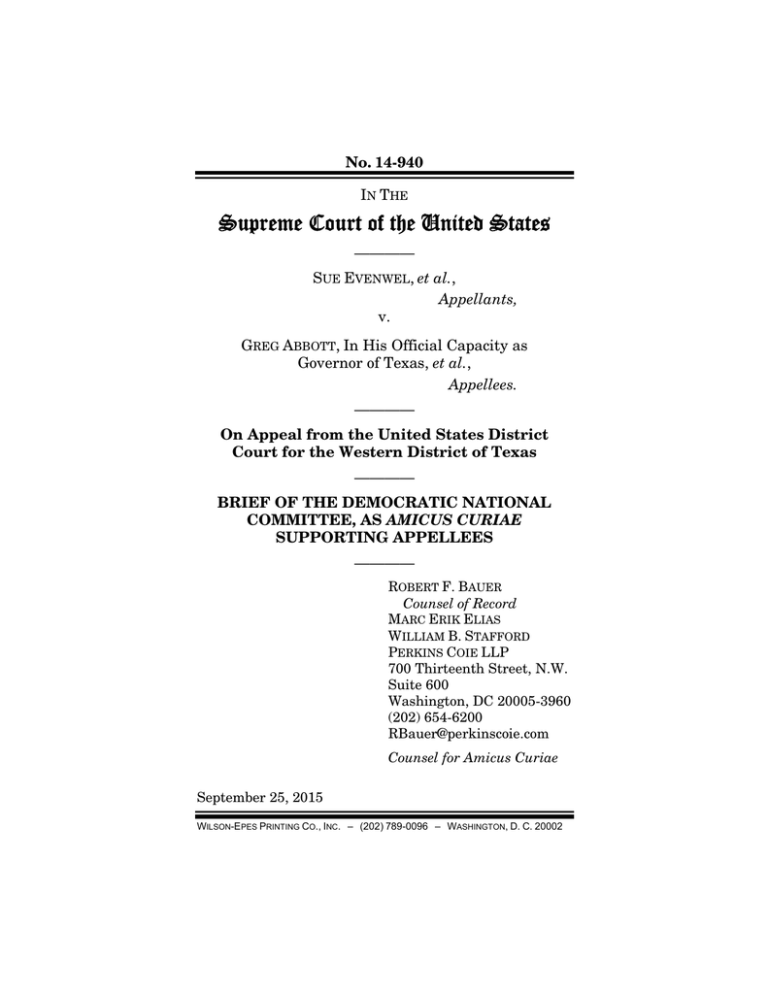
No. 14-940 IN THE Supreme Court of the United States ———— SUE EVENWEL, et al., Appellants, v. GREG ABBOTT, In His Official Capacity as Governor of Texas, et al., Appellees. ———— On Appeal from the United States District Court for the Western District of Texas ———— BRIEF OF THE DEMOCRATIC NATIONAL COMMITTEE, AS AMICUS CURIAE SUPPORTING APPELLEES ———— ROBERT F. BAUER Counsel of Record MARC ERIK ELIAS WILLIAM B. STAFFORD PERKINS COIE LLP 700 Thirteenth Street, N.W. Suite 600 Washington, DC 20005-3960 (202) 654-6200 RBauer@perkinscoie.com Counsel for Amicus Curiae September 25, 2015 WILSON-EPES PRINTING CO., INC. – (202) 789-0096 – WASHINGTON, D. C. 20002 TABLE OF CONTENTS Page TABLE OF AUTHORITIES ................................ ii INTEREST OF AMICUS CURIAE ..................... 1 SUMMARY OF ARGUMENT ............................. 1 A. All American Residents Are Entitled to Representation By Elected Officials and a Voice in American Politics ..................... 4 B. The Text and History of the Fourteenth Amendment Support Use of Total Population as the Apportionment Base of State and Local Electoral Districts .......... 9 C. The Necessary Data to Draw Districts Containing an Equal Number of Citizens Does Not Exist .......................................... 14 CONCLUSION .................................................... 19 (i) ii TABLE OF AUTHORITIES CASES Page(s) Ala. Legislative Black Caucus v. Alabama, 135 S. Ct. 1257 (2015) .................................. Bluman v. Fed. Election Comm’n, 800 F. Supp. 2d 281 (D.D.C. 2011) aff’d, 132 S. Ct. 1087 (2012) .................................. Burns v. Richardson, 384 U.S. 73 (1966) ........................................ Chen v. City of Houston, 206 F.3d 502 (5th Cir. 2000) ........................ Daly v. Hunt, 93 F.3d 1212 (4th Cir. 1996) ........................ Dep’t of Commerce v. U.S. House of Representatives, 525 U.S. 316 (1999) ...................................... Garza v. County of Los Angeles, 918 F.2d 763 (9th Cir. 1990) ........................ 4 5 4 13 17 15 7 Levy v. Louisiana, 391 U.S. 68 (1968) ........................................ 10 McConnell v. Fed. Election Comm’n, 540 U.S. 93 (2003), overruled on other grounds by Citizens United v. Fed. Election Comm’n, 558 U.S. 310 (2010) ....................... 6 McCutcheon v. Fed. Election Comm’n, 134 S. Ct. 1434 (2014) .................................. 6 Plyler v. Doe, 457 U.S. 202 (1982) ...................................... 9, 10 Reyes v. City of Farmers Branch, 586 F.3d 1019 (5th Cir. 2009) ...................... 19 Reynolds v. Sims, 377 U.S. 533 (1964) ................................ 7, 8, 9, 13 iii TABLE OF AUTHORITIES—Continued Page(s) Yick Wo v. Hopkins, 118 U.S. 356 (1886) ...................................... 10 CONSTITUTIONAL PROVISIONS U.S. Const. amend I ......................................... 6 U.S. Const. amend. XIV ..................................passim OTHER AUTHORITIES 11 C.F.R. § 110.20 ............................................ 6 Cong. Globe, 39th Cong., 1st Sess. 141 (1866) .. 13 Cong. Globe, 39th Cong., 1st Sess. 877 (1866) .. 12 Cong. Globe, 39th Cong., 1st Sess. 2986-87 (1866) ............................................................ 12 Douglas S. Massey, Residential Segregation and Neighborhood Conditions in U.S. Metropolitan Areas, in 1 America Becoming: Racial Trends and Their Consequences (Neil J. Smelser et al. eds., 2001) ................ 12 The Federalist No. 10 (James Madison) ......... 5 The Federalist No. 54 (James Madison) ......... 11 George David Zuckerman, A Consideration of the History and Present Status of Section 2 of the Fourteenth Amendment, 30 Fordham L. Rev. 93, 96-100 (1961) .............................. 11, 12 Joseph T. Sneed III, Footprints on the Rocks of the Mountain: An Account of the Enactment of the Fourteenth Amendment 35 (1997)...... 11 iv TABLE OF AUTHORITIES—Continued Page(s) The Law of the Census: How to Count, What to Count, Whom to Count, and Where to Count Them, Cardozo L. Rev. 755 (2011) .... 16 Sandra L. Colby & Jennifer M. Ortman, Projections of the Size and Composition of the U.S. Population: 2014 to 2060 ............... 7, 8 Sarah K. Cowan, Periodic Discordance Between Vote Equality and Representational Equality in the United States, 2 Soc. Sci. 442, 447 (2015) ............................................................ 12 Texas Legislative Council, Estimating Citizenship Voting Age Population Data (CVAP), Addendum to Data for 2011 Redistricting in Texas (Mar. 2013), http://www.tlc.state.tx. us/redist/pdf/addendum_2011_Redistricting. pdf ................................................................. 17 U.S. Census Bureau 10 (Mar. 2015), https:// www.census.gov/content/dam/Census/library/ publications/2015/demo/p25-1143.pdf ......... 7, 8 U.S. Census Bureau, American Community Survey (ACS), Comparing ACS Data, https:// www.census.gov/programs-surveys/acs/guid ance/comparing-acs-data.html ..................... 15 U.S. Census Bureau, American Community Survey (ACS), Sample Size Definitions, http://www.census.gov/programs-surveys/acs/ methodology/sample-size-and-data-quality/ sample-size-definitions.html ........................ 15 INTEREST OF AMICUS CURIAE Amicus curiae is the Democratic National Committee (the “DNC”), which is responsible for governing the Democratic Party. The DNC was created during the Democratic National Convention of 1848 and is the oldest continuing party committee in the United States. The DNC promotes the Democratic Platform, which is the statement of core principles at the heart of the Democratic Party, and which manifests the Democratic Party’s commitment to representation and inclusion of all people in the Nation’s political life. Among other things, the DNC coordinates strategy to support candidates throughout the country for local, state, and national office, and works with various constituencies to respond to the needs and views of Democrats across the Nation. The DNC therefore has substantial expertise in constitutional issues related to equal protection of the laws and political representation. This expertise bears directly on the issues before the Court.1 SUMMARY OF ARGUMENT The United States District Court for the Western District of Texas properly rejected Appellants’ claim that a state legislature violates the Equal Protection Clause of the United States Constitution by apportioning districts on the total population of all residents as calculated in the decennial Census—as opposed to an estimate of citizen-voting age population (“CVAP”) premised on sampling. Appellants’ claim is 1 Pursuant to Rule 37.6, the DNC hereby states that no counsel for any party authored the brief in whole or in part and no person or entity other than the DNC made any monetary contribution to the preparation or submission of this brief. 2 unsupported by the text and history of the Fourteenth Amendment and this Court’s prior jurisprudence. Amicus Curiae DNC submits this brief to note further that use of total population as the apportionment base is consonant with the basic principles of the Democratic Party and this Nation as a whole, is grounded in the text and history of the Fourteenth Amendment, and is the near-uniform practice of jurisdictions throughout the United States. The DNC therefore respectfully submits that the Court should hold definitively that state and local jurisdictions must apportion state and local districts on the basis of total population. First, use of total population as the apportionment base properly recognizes that all residents of a given geographic area—regardless of whether they are currently eligible voters—are members of this Nation’s body politic who are entitled to representation. All residents—be they children, noncitizen immigrants, or eligible voters—are members of the wider political community whose interests should be taken into account by their elected representatives. A representative serving a locality with a high percentage of children should, for example, take those children’s educational needs into account. A representative serving a locality with a high immigrant population should take that community’s needs and interests into account. Adopting Appellants’ position would be to adopt the view that all persons except eligible voters are nonentities as far as political representation is concerned. Second, use of total population as the apportionment base comports with the text of the Fourteenth Amendment and its history. In adopting a new system of representation after the Civil War, the authors of 3 the Fourteenth Amendment consciously chose to require that congressional districts be drawn on the basis of all “persons” as opposed to all “voters.” The Equal Protection Clause of the Fourteenth Amendment—the wellspring of this Court’s jurisprudence requiring that state legislative districts be drawn on a population basis—similarly extends the equal protection of the laws to all “persons.” It would be anomalous if the Fourteenth Amendment’s authors on the one hand mandated that total population be used to draw congressional districts and that voter population be used to draw state legislative districts. Third, practical considerations counsel strongly against the use of estimates of citizen population as an apportionment base. Appellants urge the Court to mandate a profound intrusion on existing redistricting practices. With limited exceptions, the uniform practice of jurisdictions throughout America is to draw districts based on total population as reported in the decennial Census. Adopting the rule Appellants advance would thus throw out (or, at the very least, call into constitutional question) nearly every state and local electoral district in the United States. There is a good reason why—to the DNC’s knowledge—there is not a single state in the country that draws districts on the basis of CVAP. The United States Census does not ask respondents to report their citizenship status. There is thus no accurate data regarding CVAP down to the census block level, as would be required to accurately draw districts of equal CVAP. The best available estimate of citizen population is derived from the American Community Survey (“ACS”), which is based on a sample of a fraction of American households and simply is not accurate to the level of granularity necessary to ensure that local 4 electoral districts contain an “equal” number of citizens. For all these reasons, the Court should affirm the judgment below and further hold that the Fourteenth Amendment requires that all persons residing in the United States must be taken into account when drawing state and local electoral districts. A. All American Residents Are Entitled to Representation By Elected Officials and a Voice in American Politics The issue before the Court goes to the heart of what it means for America to be a representative democracy. Do states have a choice between representational or political equality in apportioning districts, or is one of the two binding on them as a matter of constitutional law? The Court confronted the question about the nature of representation once before, in Burns v. Richardson, 384 U.S. 73 (1966). It chose not to answer it. Burns arose in the early days of the Court’s one-person, onevote jurisprudence, with elections in Hawaii looming and in regard to an interim districting plan. In those circumstances, the Court proceeded cautiously, determining that “[t]he decision to include or exclude any . . . group [in the apportionment base] involves choices about the nature of representation with which we have been shown no constitutionally founded reason to interfere.” Id. at 92. In the half-century since Burns, the one-person, onevote doctrine has become a central pillar of redistricting—so foundational that it is just “part of the redistricting background.” Ala. Legislative Black Caucus v. Alabama, 135 S. Ct. 1257, 1270 (2015). 5 Having concluded that the Constitution demands population equality between districts, the Court should hold that the Constitution requires “equality” within districts. The reasons lie in the American conception of the nature of representation. Our elected representatives’ task is to serve the larger good of the community rather than the interests of a few. It is on the basis of this conception that the Founders established a representative rather than a pure democracy “to refine and enlarge views of the public good, by passing them through the medium of a chosen body of citizens, whose wisdom may best discern the true interest of their country.” The Federalist No. 10 (James Madison). Nowhere is there found the contrary and extraordinary judgment that legislators answer only to those who have put them in office—that legislators and their voters are somehow bound together in a relationship of reciprocal benefit, with all other residents excluded from the represented “constituency” and looking in from the outside. Those who reside within our borders make up a political community that is not defined by eligibility to vote. In fact, the right to vote does not determine the availability of other means of political participation in this political community, such as making campaign contributions or expenditures. “[M]any groups of people who are not entitled to vote may nonetheless make contributions and expenditures related to elections—for example, minors [and] American corporations” because these nonvoters “are all members of the American political community.” Bluman v. Fed. Election Comm’n, 800 F. Supp. 2d 281, 290 (D.D.C. 2011) aff’d, 132 S. Ct. 1087 (2012). It would make little sense to speak of a “political community” comprised of 6 both voters and nonvoters, while insisting that each legislator’s constituency consists only of those who vote. And it would be similarly peculiar to construe the right to influence elections more broadly than the right to be represented by those who are eventually elected. This Court has stood firmly behind the First Amendment right of nonvoters to make political contributions to candidates. See McConnell v. Fed. Election Comm’n, 540 U.S. 93, 231 (2003), overruled on other grounds by Citizens United v. Fed. Election Comm’n, 558 U.S. 310 (2010). In McConnell, the Court struck down an absolute prohibition on contributions by minors under 18 years of age. Likewise, lawful permanent residents are entitled to make political contributions. 11 C.F.R. § 110.20. It is difficult to see how these nonvoters have a constitutionally or statutorily guaranteed right to support candidates but that in calculating those candidates’ constituency, they are to be excluded. On this view, candidates would be free to take nonvoters’ money but would owe them no duty of representation. Or worse, the nonvoters who contribute would have a call on candidates’ attention—the “access” and “ingratiation” this Court recognized in McCutcheon v. Fed. Election Comm’n, 134 S. Ct. 1434, 1441 (2014) (internal quotation marks and citation omitted)—but only because they contributed, and not on the understanding that they belong to the wider political community the legislator represents. This is a view of the polity and how it functions that the Founders surely would have rejected. For these reasons, the Court should find that states must use total population as the basis for apportionment. To leave it to the choice of 7 legislatures—while it is an alternative superior to the unacceptable course urged by Appellants—is to endorse a vision of representative democracy that cannot be reconciled with founding principles or this Court’s one-person, one-vote jurisprudence. It is also to invite a choice shaped by political calculation. The discretion to pick the apportionment base is the discretion to manipulate district lines for political gains. Moreover, excluding nonvoting residents from the apportionment base of electoral districts would send a clear message of exclusion—that these nonvoting residents are unrepresented even though they pay taxes, use government services, and are subject to American law. Such a state of affairs would bear an uncomfortable resemblance to a regime of “taxation without representation.” Those who are subject to a government’s authority have the right to hold that government to account. See, e.g., Garza v. County of Los Angeles, 918 F.2d 763, 774 (9th Cir. 1990) (“[T]he people, including those who are ineligible to vote, form the basis for representative government. Thus population is an appropriate basis for state legislative apportionment.”) (citing Reynolds v. Sims, 377 U.S. 533 (1964)). The effect of excluding nonvoters from the apportionment base would have particularly pernicious consequences for people of color. In 2014, a “much smaller percentage of the child population” was non-Hispanic White alone (52%) compared to the total population (62%).2 In other words, “[t]he racial and 2 Sandra L. Colby & Jennifer M. Ortman, Projections of the Size and Composition of the U.S. Population: 2014 to 2060, U.S. Census Bureau 10 (Mar. 2015), https://www.census.gov/content 8 ethnic composition of the United States is markedly different when looking at just children, under 18 years of age.” Id. This is particularly true for fast-growing Latino communities. Whereas 17.4% of the total population of the United States in 2014 was Latino, 24.4% of the under-18 population was Latino. Every month, roughly 66,000 Latino U.S. citizens turn 18. Of the more than 3 million Latinos who will turn 18 between 2012 and 2016, close to 60% come from immigrant households. Forcing states to apportion based on CVAP would obscure these marked demographic shifts. States typically draw new districts once every ten years. Ignoring the existence of youth populations will “lock in” underrepresentation for Latinos throughout an entire decade. In sum, in our representational democracy, elected officials represent the interests of voters and nonvoters alike. Excluding current nonvoters from the apportionment base of state and local electoral districts cannot be reconciled with the core conception of representation ingrained in our founding principles, nor with this Court’s one-person, one-vote jurisprudence. The Court should squarely address the question left unanswered in Burns and find that states and localities must use total population as the basis for apportionment. /dam/Census/library/publications/2015/demo/p25-1143.pdf. 9 B. The Text and History of the Fourteenth Amendment Support Use of Total Population as the Apportionment Base of State and Local Electoral Districts In Reynolds, this Court held “that, as a basic constitutional standard, the Equal Protection Clause requires that the seats in both houses of a bicameral state legislature must be apportioned on a population basis.” 377 U.S. at 568. The text and history of the Fourteenth Amendment further suggest that total population is the proper and, indeed, required apportionment base for state and local legislative districts. In particular, it follows from the Fourteenth Amendment’s use of the inclusive term “persons,” grounded in a principle of representational equality, that total population—not CVAP or any other metric—be the apportionment base for both congressional and state legislative districts. The Equal Protection Clause (Section 1 of the Fourteenth Amendment) provides that no state may “deny to any person within its jurisdiction the equal protection of the laws.” This language is plain and expansive. It applies to all persons within the jurisdiction of a state. Not all citizens or all voters— all persons. The historical record reflects that the drafters of the Fourteenth Amendment meant what they said. As the Court has recognized, the congressional debate regarding the Equal Protection Clause reflects that Congress intended the most expansive application, even “to ensure that the equal protection of the laws was provided to the alien population.” Plyler v. Doe, 457 U.S. 202, 213-14 (1982). 10 Thus, this Court has routinely interpreted the Equal Protection Clause to guarantee all persons the right to equal protection under the law: The fourteenth amendment to the constitution is not confined to the protection of citizens. It says: “Nor shall any state deprive any person of life, liberty, or property without due process of law; nor deny to any person within its jurisdiction the equal protection of the laws.” These provisions are universal in their application, to all persons within the territorial jurisdiction, without regard to any differences of race, of color, or of nationality; and the equal protection of the laws is a pledge of the protection of equal laws. Yick Wo v. Hopkins, 118 U.S. 356, 369 (1886) (emphasis added). That is true regardless of whether an immigrant is documented or undocumented. Plyler, 457 U.S. at 210 (rejecting the argument “that undocumented aliens, because of their immigration status, are not ‘persons within the jurisdiction’ of the State of Texas, and that they therefore have no right to the equal protection of Texas law” because “[w]hatever his status under the immigration laws, an alien is surely a ‘person’ in any ordinary sense of that term”). And the same is true of children. See id.; see also Levy v. Louisiana, 391 U.S. 68, 70 (1968) (“[I]llegitimate children are not ‘nonpersons.’ They are humans, live, and have their being. They are clearly ‘persons’ within the meaning of the Equal Protection Clause of the Fourteenth Amendment.”). The drafters of the Fourteenth Amendment did not expressly address the application of equal protection to state and local reapportionment. But Section 2 of the Fourteenth Amendment (“Section 2”)—which 11 chiefly concerns apportionment of the United States House of Representatives—sheds substantial light on the subject. Section 2 uses the same terminology and reflects the same legislative purpose as Section 1. See U.S. Const. amend. XIV, § 2 (“Representatives shall be apportioned among the several states according to their respective numbers, counting the whole number of persons in each state, excluding Indians not taxed.” (emphasis added)). Section 2 amended Article I, Section 2 of the Constitution, which apportioned representation in the House of Representatives on the basis of the whole number of free persons and “threefifths of all other persons”—i.e., slaves. The use of “persons” in Article I, Section 2, and later in the Fourteenth Amendment, ensured that the “aggregate number of representatives allotted” to each state would be “founded on the aggregate number of inhabitants.” The Federalist No. 54 (James Madison). The Founders thus knowingly included populations unable to vote—such as women, children, convicts, persons without property, and noncitizens—for purposes of congressional apportionment. In drafting the Fourteenth Amendment, Congress not only chose to echo Article I, Section 2’s “whole number of persons” language, but also expressly rejected alternate proposals that would have apportioned Representatives based on eligible voters. In an early House version of Section 2, Representative Thaddeus Stevens introduced a constitutional amendment that would apportion Representatives “according to their respective legal voters.” Joseph T. Sneed III, Footprints on the Rocks of the Mountain: An Account of the Enactment of the Fourteenth Amendment 35 (1997). But Republican majorities in Congress 12 rejected Stevens’ amendment and subsequent, similar proposals. George David Zuckerman, A Consideration of the History and Present Status of Section 2 of the Fourteenth Amendment, 30 Fordham L. Rev. 93, 96100 (1961) (describing the failure of four separate proposals to base apportionment on eligible voters). They did so recognizing that using total population as the basis of apportionment meant that districts might have widely varying numbers of eligible voters. For example, while western states had a relatively higher percentage of eligible voters given their disproportionately male-heavy populations, northern states had relatively high concentrations of foreign-born noncitizens and women, and former Confederate states were home to millions of newly freed, but disenfranchised, former slaves. Id. at 95.3 The drafters noted that 3 See Cong. Globe, 39th Cong., 1st Sess. 877 (1866) (Sen. Hendricks noting that the female population of the six New England states exceeded the male population by 50,000, while in the six agricultural states of the West—Ohio, Indiana, Kentucky, Illinois, Missouri, and Iowa—the male population exceeded the female population by 297,758); Cong. Globe, 39th Cong., 1st Sess. 2986-87 (1866) (Sen. Wilson noting that the northern states contained 2.1 million unnaturalized foreigners who would be excluded from the apportionment base if citizenship were the standard). These species of population deviations have always been features of American political life. For example, in 1910, California had 40% more men than women, whereas New York had 2% more men than women. Sarah K. Cowan, Periodic Discordance Between Vote Equality and Representational Equality in the United States, 2 Soc. Sci. 442, 447 (2015). Likewise, contrary to Appellants’ suggestion that large immigrant populations are a new phenomenon, many localities throughout American history have had significant foreign-born populations. For example, in 1960, 15.5% of the population of El Paso, Texas was foreign-born. Douglas S. Massey, Residential Segregation and Neighborhood Conditions in U.S. Metropolitan Areas, in 1 America Becoming: Racial Trends and Their 13 adopting a voter-based rather than a population-based apportionment scheme would ignore the representational interests of groups that were otherwise denied the franchise. As Representative James G. Blaine of Maine stated on the House floor on January 8, 1866: “As an abstract proposition no one will deny that population is the true basis of representation; for women, children, and other non-voting classes may have as vital an interest in the legislation of the country as those who actually deposit the ballot.” Cong. Globe, 39th Cong., 1st Sess. 141 (1866) (emphasis added).4 The historical record reflects that, by requiring apportionment on the basis of all “persons,” Congress decisively resolved the debate in favor of a representational equality model that apportioned representatives on the total number of persons, as opposed to an “electoral equality” model based on eligible voters. See Chen v. City of Houston, 206 F.3d 502, 527 (5th Cir. 2000) (“[T]he drafters of the Fourteenth Amendment, on which Reynolds itself rests, do appear to have debated this question, and rejected a proposal rooted in—among other things— the principle of electoral equality.”). Consequences (Neil J. Smelser et al. eds., 2001). 4 At the time of the Fourteenth Amendment’s passage, the franchise was still denied to African-Americans in many jurisdictions. Not until the passage of the Fifteenth Amendment were the federal and state governments precluded from denying a citizen the right to vote based on that citizen's "race, color, or previous condition of servitude." Likewise, the franchise was not extended to women for decades, until the ratification of the Nineteenth Amendment in 1920. 14 To be sure, Section 2’s apportionment scheme does not apply directly to state legislative districts and the apportionment of congressional districts raises distinct federalism concerns. But that does not mean that the text and history of Section 2 is irrelevant to the issue before the Court. It simply strains credulity that (as Appellants necessarily argue) the authors of the Fourteenth Amendment intended to use the same word—“persons”—to constitutionally mandate congressional apportionment on the basis of total population and state legislative apportionment on the basis of eligible voters. This is especially unlikely when the concept of representation adopted by the Founders is taken fully into account—the representation of all residents. Nowhere is found the suggestion that this principle was to be protected at the federal level, then abandoned at the state and local level, of American government. C. The Necessary Data to Draw Districts Containing an Equal Number of Citizens Does Not Exist Finally, the DNC notes that Appellants proffer an unworkable constitutional standard that would be highly disruptive to existing redistricting practices and highly problematic for localities to implement. This is because there is no data that definitively establishes the number of citizens and noncitizens residing in particular locales at the level of granularity necessary to conduct districting. Appellants ask this Court to establish a principle that would hold unconstitutional “deviations” in the estimates of CVAP that may well be the result of sampling errors. Even assuming the abstract merit of drawing districts based on CVAP, the data necessary to do so simply do not exist. 15 As discussed above, reapportionment is presently conducted throughout the United States using total population data from the decennial Census. The Census counts every person who lives in the 50 states, the District of Columbia, and U.S. territories. It is thus based on an actual population count and not on sampling. Indeed, this Court has held that the Census Act actually “prohibits the use of sampling for apportionment purposes.” Dep’t of Commerce v. U.S. House of Representatives, 525 U.S. 316, 342 (1999) (addressing use of sampling data by U.S. Census Bureau with respect to reapportionment of congressional districts). Appellants argue that the Fourteenth Amendment requires apportionment of state legislative districts based on “eligible voters”; i.e., CVAP. The United States Census does not ask questions about citizenship. Thus, for purposes of reapportionment, there is no actual, accurate count of the residential location of citizens and noncitizens in the United States. The most commonly used estimate of citizen population comes from the American Community Survey (“ACS”), administered by the Census. The ACS provides “estimates” based on “a sample of housing units and people in the population, not the full population.” U.S. Census Bureau, American Community Survey (ACS), Sample Size Definitions, http://www.census.gov/programs-surveys/acs/method ology/sample-size-and-data-quality/sample-size-defin itions.html. The ACS is, however, a survey, not a census. The periodic surveys done by the ACS over the last ten years were based on a sample population of 3.5 million or less. Id. That is, ACS’s estimates are based on reporting from just 2% of American households. Necessarily, then, “ACS estimates have a 16 degree of uncertainty associated with them, called sampling error.” Id. This is why the Census Bureau cautions that ACS data should be used “to obtain population characteristics (percents, means, medians, and rates) rather than estimates of population totals.” U.S. Census Bureau, American Community Survey (ACS, Comparing ACS Data, https://www.census. gov/programs-surveys/acs/guidance/comparing-acs-da ta.html. There are at least four inherent limitations of the ACS estimates of citizenship population that render the ACS survey inadequate for the task of drawing districts of equal number of citizens. See generally Nathaniel Persily, 32 The Law of the Census: How to Count, What to Count, Whom to Count, and Where to Count Them, Cardozo L. Rev. 755 (2011). First, because the ACS is a sample of a relatively small share of the population, ACS surveys do not produce data at the sufficiently local level necessary for redistricting (the census block level). Thus, while the ACS is a useful tool for capturing aggregate-level data (such as the profile of a state or large regions within a state), it is a tool that is necessarily lacking at more granular levels, because a 2% national survey often does not include enough people to provide an accurate estimate of citizenship rates in small geographic areas, such as specific neighborhoods. Second, and relatedly, the ACS does not even provide an estimate of the citizen voting age population at the census block level, which is the data used to reapportion districts. Rather, estimated citizenship data is available only at the census block group level. This is important because census block groups are often split between multiple districts. Disaggregating the estimated citizenship data from 17 the block group level to the block level thus requires use of further methodological assumptions and estimates that necessarily create further uncertainty about the estimate’s accuracy. For example, in Texas, the government entity responsible for developing data to support redistricting used a citizenship estimation methodology that meant “some people who live outside the district are included in the district estimates, and some people who live in the district are not included in the district estimates.” Tex. Legislative Council, Estimating Citizenship Voting Age Population Data (CVAP), Addendum to Data for 2011 Redistricting in Texas (Mar. 2013), http://www.tlc.state.tx.us/redist /pdf/addendum_2011_Redistricting.pdf. In other words, redistricting using CVAP requires the use of an estimate on top of an estimate, with all the attendant lack of precision that entails. Third, because the ACS is a survey, and not a census, it is backward-looking. That is, the ACS provides estimates of what citizenship rates were in the past, rather than an accurate count of citizenship rates at the time of redistricting (which the Census itself provides) “with regard to total population.” Finally, use of CVAP to reapportion districts would systematically undercount young voters, excluding from the apportionment base young citizens who turn 18 after completion of the decennial redistricting process. See, e.g., Daly v. Hunt, 93 F.3d 1212, 1228 (4th Cir. 1996) (“[U]sing voting-age population as the apportionment base would ignore the voting strength of those persons who are between the ages of 8 and 17 at the time of the apportionment, but who would become eligible to vote before the next apportionment.”). Moreover, because the under-18 population in America is much more diverse than the over-18 18 population, the use of CVAP would also disproportionately exclude persons of color from the count of a district’s population. Appellants’ brief elides the fundamental “data” problem with their claim entirely, while still reflecting it. For example, in Tables 2 and 3 in their brief, Appellants present data reflecting the supposed “deviations” in “voting power” in Senate Districts 1 and 4. Appellants provide three separate estimates of the citizen population of these districts, based on three separate ACS surveys. Appellants do not provide the margin of error for these various estimates (or acknowledge that one exists). And the three estimates of CVAP vary widely; by more than 16,000 among the three estimates in Senate District 1 and by roughly 27,000 in Senate District 4. These are not trivial differences. As the organizing body of the Democratic Party, the DNC has a keen interest in the composition of the myriad state and local districts in the United States, all of which are based on total population or some derivation of it. If this Court holds that states must redistrict using CVAP estimates, all of these districts will be unconstitutional or, at the very least, have their constitutionality called into serious question and subject to legal challenge. Further, given the inherent limitations of the ACS survey, the floodgate of litigation that would be opened by the mandated use of CVAP would pose thorny methodological questions. What effect does the margin of error have on the maximum permissible population deviation between districts? Does the Fourteenth Amendment mandate a particular methodology for calculating a CVAP estimate at the census block level? If not, are there any restrictions on a local redistricting body’s 19 discretion to calculate a redistricting purposes? CVAP estimate for These questions presently have no answer because no court has ever held that the Fourteenth Amendment mandates the use of CVAP in reapportioning state and local legislative districts. The DNC respectfully submits that the basic impracticality of using CVAP estimates as the basis of apportionment counsels strongly against the adoption of the constitutional rule for which Appellants advocate.5 CONCLUSION Appellants ask this Court to issue a holding that would either strike down every legislative district in the country or render it susceptible to immediate legal challenge. And they ask the Court to do so based on an “electoral equality” theory that is completely untethered from constitutional text, precedent, and practice. It is a theory that disregards and would indeed undermine the founding American conception of representation—that elected representatives consider and serve the interests of all residents, because they are expected when elected to attend to 5 To be sure, ACS estimates of CVAP may be used appropriately for other purposes. For example, a plaintiff might claim, under Section 2 of the Voting Rights Act, that a jurisdiction’s failure to draw a “majority-minority” district diluted the vote of the minority population in question. Some circuit courts have held that such a plaintiff must show, by a preponderance of the evidence, that it is possible to draw a district where the minority group in question forms a majority of the district’s CVAP. See, e.g., Reyes v. City of Farmers Branch, 586 F.3d 1019, 1022-23 (5th Cir. 2009). If a plaintiff could not use ACS estimates for that purpose, no plaintiff could ever present a viable claim under Section 2. CVAP estimates are the best available data for this purpose. 20 the interests of the whole political community of voters and nonvoters alike. The Court should reject this unsupportable theory and instead—in the course of upholding Texas’ use of total population to draw its senate districts—hold now and conclusively that “total population” is the measuring stick for compliance with the “one-person, one-vote” mandate of the Fourteenth Amendment. Respectfully Submitted, ROBERT F. BAUER Counsel of Record MARC ERIK ELIAS WILLIAM B. STAFFORD PERKINS COIE LLP 700 Thirteenth Street, N.W. Suite 600 Washington, DC 20005-3960 (202) 654-6200 RBauer@perkinscoie.com Counsel for Amicus Curiae September 25, 2015
